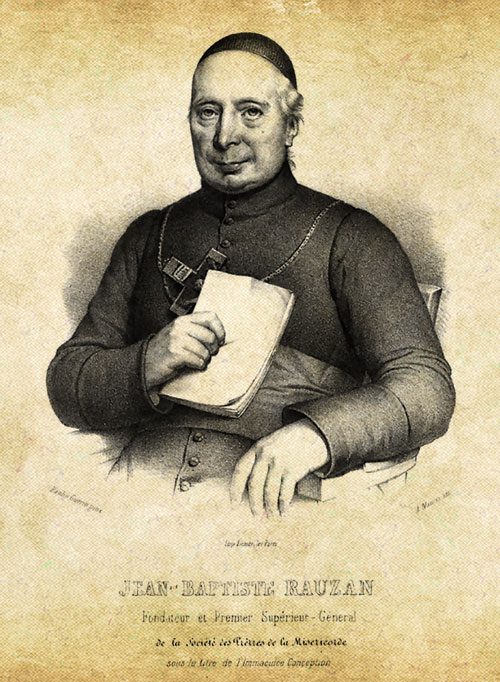“The harvest is plentiful, but the laborers are few” (Matt. 9:35-38)
The story of the Fathers of Mercy begins in response to the French Revolution, when the great upheaval and persecution of the Catholic Church took place in France. During this time, many of the French people abandoned their faith and had fallen into the depths of immorality, rejecting all sense of devotion and religion in order to worship man’s own reason and sensuality. Truly France was in need of a spiritual restoration.
Seeing the devastated state in which the evils of the French Revolution had left the eldest daughter of the Church, the Archbishop of Lyons, Joseph Cardinal Fesch, the uncle of Emperor Napoleon, in 1808 asked a zealous priest, Father Jean-Baptiste Rauzan to gather together a group of priests that had a thirst for the salvation of souls to take up the task of re-evangelizing a now pagan France. Father Rauzan’s desire to bring God’s prodigal children back to God led him to accept this request and form what was then called the Missionaries of France. He began with five priests who would go from town to town giving city wide missions staying there for weeks at a time. The Missionaries would preach to the people of the town, calling them to a conversion of heart, pleading with them to return to God their Father who waits for them with open arms. They would refute the errors of modernism which became the new doctrine of the people and once again bring the practice of Catholic devotion back to the city. Finally, through the sacrament of confession the Missionaries of France would bring the lost sheep back into the fold where they would be nourished by the Sacrament of the Eucharist.
In 1814, a Mother House for the community was established in Paris where some of the fathers were placed in charge of several churches. These places became locations where perpetual missions were being preached to those that would come from great distances to hear the Missionaries of France. Hence, parochial work was added to their task of saving souls and continues to this day.

Pope Gregory XVI approves the new Congregation
Fr. Rauzan, desiring to solidify his work and receive the formal blessing of Holy Mother Church, moved to Rome to write the Constitutions for the new community and to seek papal approval. In 1834, Pope Gregory XVI approved Fr. Rauzan’s work and gave them the name, The Society of the Priests of Mercy, and making them a Marian community placed them under the patronage of the Immaculate Conception. Pope Gregory, in approving the Society’s Constitutions, said; “We most earnestly desire that there be formed among the clergy, men joined in a society and aflame with love for the Divine Glory and zeal for the salvation of souls. We desire to show such ecclesiastical men a singular mark of our favor, especially in these times so difficult for Christianity and society, against whom certain monstrous systems, sprung from the depths, and every day with greater license spew forth their poison with the greatest harm to souls. It is, therefore, with no little satisfaction that We have received our well-beloved sons, the Priests of the Society of Mercy under the title of Blessed Mary, Immaculate in her Conception, performing the function of missionaries to learn that they have no other end than to … consecrate all their energies to the salvation of souls.” This approval by the Vicar of Christ made the work of Father Rauzan, our founder, a work of the Church.
THE FIELD OF LABOR BROADENS
In 1839, Fr. Rauzan sent some of his missionaries to the United States with hopes that they could continue the work of saving souls. These zealous priests were very successful in ministering to the French immigrants and traveling across the various American states seeking to save souls any way they could, preaching and administering the sacraments to all. The Fathers of Mercy had great success in their missionary activities in America and established a firm presence here through the work of many of their great priests.
After the death of Fr. Rauzan in 1847, the Society stayed in France, continuing their efforts in calling back God’s children who had fallen away, until 1905 when the anti-clerical Third Republic of France legislated the separation of Church and State, confiscated Church property, and drove out religious communities. Consequently, the Society left France and moved many of their members to the United States where the Society was already well established. By the 1940’s the Society of Priests of Mercy existed only in the United States, with the exception of a house of studies in Rome, and at this time the Vatican considered the Society an American community.
In 1961, through the intervention of Rome, the community was elevated from the status of a society to that of a congregation; thus, the community was renamed the Congregation of the Priests of Mercy (CPM) and asked to renew their efforts in the work of bringing back the prodigal children of God and being dispensers of His Mercy. They were asked once again to walk in the footsteps of the great Fathers of Mercy missionaries that came before and sacrificed their entire lives for the salvation of souls. The Fathers of Mercy now continue this work by going from parish to parish a week at a time preaching the truth of the Gospel to the people and administering the sacraments as well as staffing shrines and parishes that have been spiritually neglected. The Fathers of Mercy continue the work of their founder whose goal was to renew, through the dispensation of God’s infinite mercy, the lives of those Catholics who have become lost.